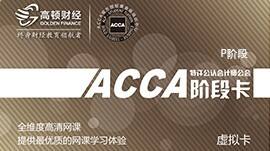2010年12月ACCA考试考官报告(P5)
General Comments
Firstly,I would like to offer my congratulations to all of those candidates who achieved a pass at this diet and my commiserations to those who did not.
The examination paper comprised two sections,A and B.Section A consisted of two compulsory questions for 60 marks in total.Section B consisted of three optional questions for 20 marks each from which candidates were required to answer two questions.
It was pleasing to see a large number of candidates providing good answers to every question they attempted and consequently achieving high marks.Sadly,the examination revealed a large number of candidates who were either inadequately prepared for the examination or failed to read the question requirements carefully.The performance in this diet was poorer compared to previous diets partly to be due to an inability of some candidates to be flexible in their approach to the examination.As a final level paper,candidates cannot expect there to be one standard answer to all questions on a given topic.The examination is intended to make the candidate apply their knowledge to a given scenario and that scenario will always present new challenges.
As in previous diets,in general,candidates are demonstrating good skill at description but are weaker on analysis.This is a lesson that has gone unlearned from previous diets.An example of this was in Q4 (b) where an analysis of a given table of data was required.This is a core skill for any commercially valuable accountant much like being able to read a set of accounts.Therefore,these should be straight-forward marks as this skill is building on those tested at previous levels in the qualification.It is apparent that many candidates believe that because the basic application of this skill has been tested at a lower level,it is thus excluded from later diets.This is wrong!
At the professional level,you can expect skills and knowledge obtained at previous levels to be tested but now in a more complex and realistic scenario.Candidates should remember that the examination is intended to be a test of their ability to ‘add value’ in their work.They can demonstrate that ability by doing things that those they are reporting to cannot – picking out the nuggets of gold from the pile of dirt.Thus,good characteristics to develop in the interpretation of questions are the strength of will to maintain focus on the overall objectives,the keen-sight to identify the driving factors of performance and the breadth of knowledge to be able to suggest methods of performance improvement.
Presentation of answers continues to show improvement and more candidates are obtaining higher professional marks as a result.One area that could still be improved is the use of subheadings to break up long answers and in particular,making sure that question sub-parts are all clearly indicated.Candidates should also note that bullet point answers often do not give sufficient detail to earn good marks.
As usual,the examination presented a challenge in the efficient use of the candidates’ time.However,well-prepared candidates found this no issue in providing good,complete answers to all questions.It was noticeable that those candidates who failed to complete all of the questions were ones who did not have a clear grasp of the question requirements and the basic knowledge required.As a result they spent considerable time writing irrelevant or vague answers that gained few marks.
Specific Comments
Question One
The question requested sections of a report on the identification and linking of critical success factors (CSFs) to key performance indicators (KPIs) and the subsequent impact of these choices on the information systems of a film production company (FP).
In general,answers to requirement (a) were weak with few of candidates gaining maximum marks by ensuring that their example metrics were relevant to FP.The problems were due to a lack of knowledge of the definition of monitoring and building CSFs and a lack of familiarity in using CSFs.
This became more apparent in responses to requirement (b) which was poorly attempted.This part asked for the information used in setting CSFs and then,using their reading of the scenario and general business knowledge,suggestions of suitable CSFs.Many candidates were unable to address this part of the question due to lack of knowledge of the definition of a CSF and devoted their answer purely to KPIs,as a result scoring no marks.Those candidates that read the question requirement and responded to it were quickly rewarded.
Requirement (c) was generally well answered with many candidates getting 7 or 8 out of 10.The best answers were those that used the question requirement to give a methodical structure to their answer.Those candidates who did not score well tended to provide bullet point lists of many KPIs when the question asked for four.Candidates should look at the total marks available for the question part and realise that they are expected to develop points about each KPI suggested,not simply identify them.
Requirement (d) was generally adequately attempted.The better answers clearly linked the KPIs to changes that would be required in the design and use of the information systems mentioned.Thus,they could demonstrate knowledge of how such systems operate and the use to which the information produced is subsequently put.
There were 2 professional marks available for this question and these were given under the headings:use of subheadings,professional language and clarity.Candidates should note that they were asked for sections and not the full report.Therefore,the standard report header,introductions and conclusions were not required except as appropriate to each section itself.(No harm was done if these were produced but mostly they wasted time.)
Question Two
This question presented data on a manufacturer (RL) that provided laptops for use in dangerous environments.
In part (a),candidates were asked to evaluate a traditional costing method with an activity-based one (ABC).
Calculations of the result of using both these methods were possible and expected.There were significant variations in the overall quality of candidates’ answers to this question.Those candidates who could correctly calculate the relevant costs scored well as they could then provide specific evidence for their recommendations about the two methods.Indeed,a good number scored 12 or more out of 15.Those that then continued the calculations to consider the main commercial implications of the two methods on the pricing at RL often scored full marks.Sadly,a number of candidates did not appear to know how to use the ABC method which should be considered a basic technique for a management accountant.
In part (b),candidates were asked to explain a ‘beyond budgeting’ approach and evaluate its use at RL.This part was generally well attempted although candidates often were sketchy on the details of implementation of this approach.It was pleasing to see many candidates analysing the environment for RL as competitive and innovative and applying these as criteria for judgement about whether the beyond budgeting approach suited the company.This is a good example of making the answer specific to the scenario.
Question Three
This question requested a discussion and evaluation of the use of value-based approaches to performance management at a chain of gift shops (LOL).
Requirement (a) requested an explanation of value-based management (VBM) and how it aids management focus.Candidates often scored a pass but not full marks on this part.There were often lengthy and irrelevant discussions about non-financial factors which suggest incomplete knowledge of VBM.
Requirement (b) asked for an evaluation of LOL’s performance using EVA,EPS growth and the share price.It was also typically passed but few candidates scored 9 or more out of 12.The assessment of the numerical work was often lacking.Candidates infrequently compared the change in share price of LOL to the market and sector performance-which demonstrated that the company was doing well in a falling market.Some candidates could not perform the EVA computation which was surprising as this is a key performance measure and the scenario offered few of the possible technical adjustments.Having performed the calculation of EVA,a significant minority then failed to note that it was positive choosing to focus on the fact that it had fallen from the previous year.This again showed weak understanding of such a key concept.
Requirement (c) was the most difficult part of the question and was generally poorly done,probably as a result of the failure to explain VBM which was illustrated in part (a).
Question Four
Question Four is set in a telecommunications company which has set targets for the reduction of its environmental footprint.The question asks for the factors in the business environment that will affect this strategy,an evaluation of its current performance in reaching the target and suggestions for further data which could measure the effectiveness of certain initiatives mentioned in the question.
Part (a) was generally well done although a number of good candidates ignored the request for illustrative performance indicators.
Part (b) was an analysis of a table of raw data which showed up basic weaknesses in some candidates’ skill set.It was well-answered by only a minority of candidates.
Many candidates wasted their time by limiting their comments to only writing out lists of statements such as 'Commercial Fleet Diesel use has fallen from 105.4 to 70.1' or even 'Commercial Fleet Diesel use has gone down'.First,this is stating the obvious to anyone who read the table but also,this is far too detailed for most reporting purposes.
An appropriate plan of attack for this part might have been:
1.consider the ‘big picture’-whether the overall target for emission reduction be met;
2.break down the data into smaller but meaningful (and manageable) chunks-Road,Rail and Air transport; and
3.discuss the individual lines of the data table focussing on the data that explains the overall picture of emission changes,for example,the switch from petrol to diesel powered motor vehicles is complete in commercial vehicles and has lead to large reductions in emissions but such a change may be more difficult in company cars as employees may resist such a change.
Good candidates analysed the numerical data given in the scenario.They created information from the data given and provided the reader of their answer with new insight into the key factors driving the reduction in emissions.
Part (c) was often poorly done as a result of the failure to address the requirement which asked for the data to be related to the reduction initiatives mentioned in the scenario.Many candidates got a mark for general suggestions of further useful data but few related this to the reduction initiatives.
Question Five
The question was about using different models for predicting corporate failure related to a manufacturer of battery packs (RMB).
Part (a) required a general discussion of the strengths and weaknesses of both qualitative and quantitative models. This was generally done well although some candidates tried to structure their answer as the strengths and weaknesses of models in general which would not be a helpful method in real life,where a comparison of the models is likely to be more useful.
Part (b) asked for comments on an analyst’s spreadsheet which provided the data and results of a Z-score calculation.Answers to this part were generally good although many candidates restricted their comment on the Z-score to repeating the comment given in the question (RMB is ‘at risk of failure within two years’) when the data given was requiring a more analytical answer about which factors within the model were driving the score down and so leading to this prediction.A minority of candidates restricted their comments to the company’s statements of income and financial position when the question required comment about the spreadsheet data and consequently their answers lacked relevance.
Part (c) asked for the application of qualitative-type models to failure prediction at RMB.This was generally well done with many candidates making good use of the Argenti model and the factors mentioned in the scenario.Unfortunately,some candidates ignored the word ‘qualitative’ in the requirement and wasted time writing about quantitative factors.
Part (d) was poorly answered with many candidates ignoring the requirement to assess the results of previous answers and only picking up marks for suggesting additional data to gather.

相关阅读
2012年12月ACCA考试P4考试考官报告2013/06/19
2012年12月ACCA考试P3考试考官报告2013/06/19
2012年12月ACCA考试P2考试考官报告2013/06/19

















